Island Stories:
![]() Danzig
Mine
Danzig
Mine
![]() Zeballos
Iron Mine
Zeballos
Iron Mine
![]() Conuma
Peak 1910
Conuma
Peak 1910
Alexandra Peak
Argus Mountain
Bate/Alava Sanctuary
Beaufort Range
Big Interior Mtn
Big Interior Mtn 1913
Part 1
Part 2
Bolton Expedition 1896
Cliffe Glacier
Clinton Wood
Comox Glacier
Comox Glacier 1922
Comox Glacier 1925
Comstock Mtn
Conuma Peak
Copper King Mine
Crown Mtn
Elkhorn 1912
Elkhorn 1949
Elkhorn 1968
Eugene Croteau
Golden Bullets
Golden Hinde 1913/14
Golden Hinde 1937
Golden Hinde 1983
Harry Winstone Tragedy
Jack Mitchell
Jim Mitchell Tragedy
John Buttle
Judges Route
Koksilah's Silver Mine
Landslide Lake
Mackenzie Range
Malaspina Peak
Mariner Mtn
Marjories Load
Matchlee Mountain
Mount McQuillan
Mt. Albert Edward
Mt. Albert Edward 1927
Mt. Albert Edward 1938
Mt. Becher
Mt. Benson 1913
Mt. Benson
Mt. Doogie Dowler
Mt. Colonel Foster
Mt. Hayes/Thistle Claim
Mt. Maxwell
Mt. Sicker
Mt. Tzouhalem
Mt. Whymper
Muqin/Brooks Peninsula
Nine Peaks
Queneesh
Ralph Rosseau 1947
Rosseau Chalet
Ralph Rosseau Tragedy
Rambler Peak
Red Pillar
Rex Gibson Tragedy
Sid's Cabin
Steamboat Mtn
Strathcona Park 1980's
The Misthorns
The Unwild Side
Victoria Peak
Waterloo Mountain 1865
Wheaton Hut/Marble Meadows
William DeVoe
Woss Lake
You Creek Mine
Zeballos Peak
Other Stories:
Sierra
de los Tuxtlas
Antarctica
Cerro del Tepozteco
Citlaltepetl
Huascaran
Mt. Roraima
Nevada Alpamayo
Nevada del Tolima
Nevado de Toluca
Pico Bolivar
Popocatepetl
Uluru/Ayers Rock
Volcan Purace
Volcan San Jose
Victoria
Peak:
Home
of the Mythical Thunderbird
by Lindsay Elms
For European's, Victoria Peak's isolated and airy summit has the modest distinction of being the third highest mountain on Vancouver Island, however, for the First Nation's People, the mountain is honoured with a greater reverence: it is the home of the mythical Thunderbird. Considered the most powerful of all native spirits, thunder would roll in the wake of the great birds wing beat and lightning would illuminate the heavens from the Lightning Snake which was worn as a belt by the Thunderbird. It was a bird that exuded power and demanded respect and in native hierarchy very high ranking and powerful chiefs could only take its crest. As a sign of its authority, the Thunderbird's symbol of out-stretched wings dominated the top of the Totem Pole in native carvings.
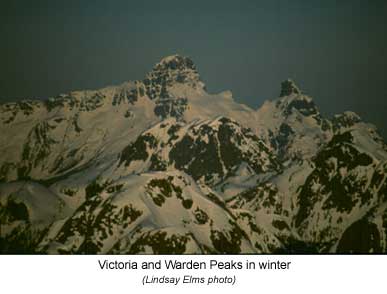 At
2,163 metres (7,095ft), Victoria Peak is a meager three metres lower than
the second highest peak Elkhorn
but a sizeable thirty-seven metres lower than the Golden Hinde. On paper
it appears to be a significant difference, but if all three peaks were
to stand next to each other it would be hard to discern which of them
would be the higher. However, because geographically Victoria Peak stands
alone, its height appears much greater. Maps drawn of Vancouver Island
in the late 1800's showed its height as being closer to 7,848 feet, at
that time over six hundred feet higher than Elkhorn. These figures were
all rough calculations made with techniques that had large variances,
but with better equipment and more accurate methods, surveyors were later
to prove that Victoria Peak was significantly lower.
At
2,163 metres (7,095ft), Victoria Peak is a meager three metres lower than
the second highest peak Elkhorn
but a sizeable thirty-seven metres lower than the Golden Hinde. On paper
it appears to be a significant difference, but if all three peaks were
to stand next to each other it would be hard to discern which of them
would be the higher. However, because geographically Victoria Peak stands
alone, its height appears much greater. Maps drawn of Vancouver Island
in the late 1800's showed its height as being closer to 7,848 feet, at
that time over six hundred feet higher than Elkhorn. These figures were
all rough calculations made with techniques that had large variances,
but with better equipment and more accurate methods, surveyors were later
to prove that Victoria Peak was significantly lower.
Towering above the White River, Victoria Peak was described by an early explorer as: "…an isolated cone of bare rock, sparsely timbered on its eastern and western slopes, but to the northern aspect perfectly nude." This picture failures to conjure up a mountain whose airy buttresses, ridges and broken glaciers, would inspire mountaineers to tread its summit, however, since those words were written over one hundred years ago, Victoria Peak has attracted climbers to test their skills and prowess on the steep rock.
Whether Victoria Peak was first climbed prior to 1960 is unknown, maybe reaching its summit was all in a days work and nothing was thought about it, which was often the case with the early surveyors. The first ascent of the Golden Hinde is a classic example of this situation. Later, ascentionists were never sure of the exact route of those who preceded them as mountaineering was in its infancy and few journals were kept. The majority of the public were not interested in the antics of the few who partook in this, what was considered at the time, a frivolous sport of the rich.
However, the first recorded ascent of Victoria Peak can be credited to Frank Stapley and Dave Williamson (a logger from Campbell River) in August 1960. Stapley was born near Calgary, Alberta in 1929 and moved to the Comox Valley in the mid 1930's where his family lived on the Urquhart Farm off Back Road. Stapley was actively engaged with the Scouting movement, coached softball and was involved with the recreation centre. Although one of his main passions was skiing which local skiing guru Herb Bradley helped him become involved in, it was his love of the mountains and helping others that many remember him for. Frank Stapley led many trips into Marble Meadows, the Comox Glacier, Flower Ridge and the peaks of Strathcona Park with both friends and family but he also enjoyed the solitude of hiking by himself. He climbed the Golden Hinde several times, Elkhorn, Mount Colonel Foster and later went on to climb Mount Robson in the Canadian Rockies and attempted Mount Waddington in the Coast Range. Unfortunately, he passed away in 1978 at the age of forty-eight leaving a young family.
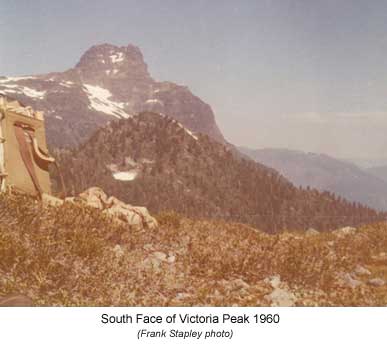 Stapley
and Williamson left Campbell River in Williamson's beat-up old truck and
drove up the White River from Sayward and into Stewart Lake. From the
end of the road they hiked up Consort Creek and onto the South Ridge of
Victoria Peak where they set up a camp. The next day they reached the
base of the South Face where they found one fifty foot pitch that required
the use of their rope but after that it was fairly straight forward scrambling
to the summit. Later they intimated to Dick Culbert, who wrote the Alpine
Guide to Southwestern British Columbia, that they had made the first
ascent of Victoria Peak, unfortunately Culbert incorrectly dated the ascent
as 1961 which for many year created some confusion.
Stapley
and Williamson left Campbell River in Williamson's beat-up old truck and
drove up the White River from Sayward and into Stewart Lake. From the
end of the road they hiked up Consort Creek and onto the South Ridge of
Victoria Peak where they set up a camp. The next day they reached the
base of the South Face where they found one fifty foot pitch that required
the use of their rope but after that it was fairly straight forward scrambling
to the summit. Later they intimated to Dick Culbert, who wrote the Alpine
Guide to Southwestern British Columbia, that they had made the first
ascent of Victoria Peak, unfortunately Culbert incorrectly dated the ascent
as 1961 which for many year created some confusion.
Another early contender for the first recorded ascent of Victoria Peak was Syd Watts. Watts was born in Old's, Alberta in 1927 and moved to Duncan with his family in 1937 where he still lives today. Soon after arriving he joined the scouting movement and had his first mountain experience on the local Mount Prevost. In the early 1950's he joined the local section of the Alpine Club of Canada and went on as many trips as he could. Unfortunately, by 1958 he was becoming discouraged with the trips organized by the ACC (too many trips off the island) so Watts and Harry Winstone formed the Nanaimo based Island Mountain Ramblers whose objectives were manly island orientated. Watts has explored and climbed on Vancouver Island for fifty years and has become an authority on its alpine history and there are few places he hasn't been.
Syd Watts, Keith Morton and Bill Lash flew into Stewart Lake to the east of the Victoria Peak on the Labour Day weekend (early September 1960) but it was unknown to them that Stapley and Williamson had been in before them. It is suggested that it was two weeks before Watts et al but Phyllis Stapley (Frank's widow) was unable to find any reference of the exact date .She has photos with a date of September 1960 printed on the back and said that at the time photos had to be printed in Vancouver and it took a couple of weeks for that to be done.
From the lake they had four days to climb the peak before they were due to be picked up again. That first day they hiked up through the meadows of Consort Creek and onto the ridge to the south of the peak where they set up camp. The next day they climbed to the summit via the South Face but upon reaching the summit found a cairn already built on top. There was nothing inside to say who had erected the cairn but Watts had always assumed it had been surveyors, however, there are no records of surveyors taking azimuth readings from the summit of the peak.
Watts flew back into Consort Lake on the Labour Day weekend (September) 1966 with combined party from the IMR and CDMC that consisted of Don Apps, Otto Winnig, Ron Facer, Doreen and John Cowlin, and Patrick Guilbride. Again the peak was climbed via the same route that Watts had climbed it by six years previously. The valleys surrounding Victoria Peak were still pristine old growth forests at the time and there were no logging roads penetrating within easy reach of the peak they way they do today.
Access into Victoria Peak remained problematic for many years until the logging roads eventually penetrated the upper reaches of the White River and Gold River watersheds. Wooded slopes from the west above Twaddle Lake near White Gold Pass gave climbers access to the easy southern ridge leading to the base of the South Face. Nice campsites can be found around some of the alpine tarns that dot the ridge for those who want a leisurely two day trip, however, because of the easy access, the mountain can be climbed as a relatively easy day climb from the vehicle. From the White River logging roads cut back under the mountain and later a flagged route was established from the northwest giving access to not only Victoria but also the slightly lower Warden Peak.
From a camp at one of the tarns the southern ridge gradually ascends to a deep notch that separates the ridge from the face. A little backtracking is necessary to find a cairned descent route down to the east onto the snow and scree at the base of the South Face. Although there is a steep two pitch low 5th grade route through the bluffs near the notch, an easy ledge systems cuts east under the bluffs to the Southeast Ridge. The route then angles back to the left, where a short steep pitch accesses the easy rubble strewn South Face. There are no technical difficulties involved for the rest of the route as it angles west up to the main summit.
Winter is a harsh time of the year on Vancouver Island if you want to get out into the mountains. With around twelve fronts coming through a month on average that doesn't leave too much time in-between the storms to accomplish a first winter ascent, let alone complete a new route. Only a couple of the more serious mountains had winter ascents by the early 1980's: Elkhorn in February 1968 by Paul Busch and Alister Watts, and Mount Colonel Foster in January 1978 by Joe Bajan and Ross Nichol. Victoria Peak was plum for the picking.
Rick Johnson, a Victoria climber who in the mid 1980's was attempting climbs that were not only personally challenging but also carrying on where the likes of Joe Bajan and Mike Walsh had left off. "We here on the island were just doing a little catching up to what the rest of the world has done for a long time and I was almost embarrassed we were not wading in given the opportunity." Obviously he was very determined to see this sort of thing being accomplished especially during the winter months and said in an interview in 2005: "One thing is for sure, I wish a new generation would take up this aspect of the 'Great Game' and take on the winter challenge that this Island offers. Rock gymnastics and 5.14d are all great and dandy. However, winter climbing is a great place to really challenge your skills to the limit though."
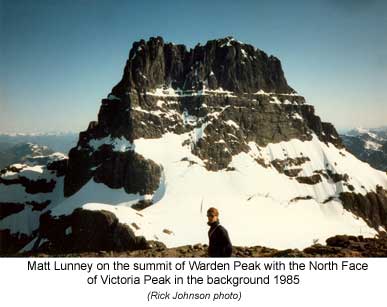 In
January 1986 Rick Johnson with Matt Lunny and Don Newman decided to have
a go at the first winter ascent of Victoria Peak by its North Face. None
of them had ever tried Victoria Peak before but Johnson and Lunney had
climbed neighbouring Warden Peak and decided to give it a go after they
saw the face.
In
January 1986 Rick Johnson with Matt Lunny and Don Newman decided to have
a go at the first winter ascent of Victoria Peak by its North Face. None
of them had ever tried Victoria Peak before but Johnson and Lunney had
climbed neighbouring Warden Peak and decided to give it a go after they
saw the face.
The three drove up island to Sayward and then ventured up the logging roads of the White River to where they picked up the flagged route that was the start of the climb. The conditions were looking good: the weather was clear and crisp and the snow pack good, although not really consolidated. They ascended the big snow filled gully up to the col between Victoria and Warden Peak and dug a snow hole for the night. Next morning they started at around 6:30 A.M. up a prominent snow ramp for a hundred feet or so and then roped up. Their line was then direct to the bottom of a prominent chute one hundred feet shy of the summit. Johnson wrote:
It was starting to look a little serious here and we all gave it a go but we just didn't have the pro (stubby pin off a so so belay) and didn't feel like testing our luck too much. We probably got up about thirty feet from the belay and said enough. Matt and Don were in top rock climbing form, 5.11+ men with good wall experience, but it just wasn't going to happen. We may have been able to cut up to the right, but no pro here either. We could see clouds ripping over the summit above us. We were a little bummed but thought maybe another generation will crack this and hopefully without bolts. We purposely didn't pack any bolts. We had all been raised on the 70's and 80's ethic where bolts are mainly for girly men. So now, it was getting late and we had planned to do a long day push with just light bivvy gear, so we rapped off.
That had its moments too (problems with pro at night!). It had been lots of short little thirty to forty foot bluffs covered in rime and verglas interspersed with steep snow ramps and faces. A couple of the bluffs were full on otherwise it was fine. We laughed like hell when Matt's feet came flying off as he neared the top of one of these bluffs and there he was hanging on his tools.
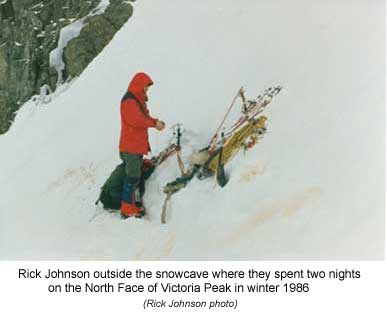 They
arrived back at their bivvy hole around 9:00 P.M. and camped out for the
second night before returning to the vehicle the next morning. What his
account fails to convey is the mental stamina required to spend all day
on a climb in the shade out of the sun and in sub zero temperatures. For
the belayer there is a lot of standing around trying to keep warm while
the leader struggles to gain height on the given pitch. But for the winter
climber this is all part of the game - he has the right clothing and gear
and is mentally prepared to endure the discomfort of the cold.
They
arrived back at their bivvy hole around 9:00 P.M. and camped out for the
second night before returning to the vehicle the next morning. What his
account fails to convey is the mental stamina required to spend all day
on a climb in the shade out of the sun and in sub zero temperatures. For
the belayer there is a lot of standing around trying to keep warm while
the leader struggles to gain height on the given pitch. But for the winter
climber this is all part of the game - he has the right clothing and gear
and is mentally prepared to endure the discomfort of the cold.
Johnson wanted to emphasize that although the short section that they failed to climb was hard, the rest of the climb wasn't too bad. He has never been able to rate this climb but has repeatedly been pressured for a grade on it. "That's difficult when you didn't actually get up the thing though," Johnson said.
So this last pitch when and if it's ever climbed will go very hard indeed. No mistake there. Personally, I'm reluctant to grade something in winter. Sandy Briggs' first rule of mountain climbing applies - conditions are everything. Lets just leave it at this. Who ever climb's this pitch will be have impressed themselves and me and will agree it was hard. It will be well earned.
Although some of these climbers are "weekend warriors" there are some with respectable CV's, take for instance Matt Lunny. Lunny started climbing in 1976 when his parents told him he could choose any sport other then than football as it was too dangerous. He grew up crack and multi-pitch trad climbing at Squamish and then branched out into mountaineering with an ascent the Emperor Ridge on Mount Robson, and a number of 6,000 metre peaks in the Andes of South America. At the same time he started sport climbing and has redpointed or onsighted over twenty-five 5.12's to date. He is a member of the Association of Canadian Mountain Guides and developed and ran the University of Calgary climbing wall for 6 years before opening the Stronghold Climbing Gym in Calgary in 1995.
On August 16, 1986 Don Newman was back again this time with Greg Foweraker. Foweraker was considered one of the hard men at Squamish frequently climbing 5.11 or harder on the superb granite bluffs. He later went on to climb in the Karakoram attempting a route on the Trango Tower in 1989 and then putting up a spectacular rock route on Shipton Spire with Greg Child et al in 1996. He also completed the first traverse of the Waddington Range in the Coast Mountains of British Columbia with Don Serl and Peter Croft in 1985. Newman suggested they attempt the unclimbed Northeast Buttress on Victoria Peak to the left of his unfinished route on the North Face.
The two arrived late Saturday night at the trailhead beside the White River after the long drive up island. Next morning they left their camp at 8 A.M. for the ascent. After making their way across logging slash for one hundred metres they picked up the flagging beside a small creek and followed it up to a basin containing a picturesque mountain lake. An obvious chute that in winter is snow filled but now bare with rock led to the col between Victoria and Warden. They then moved up steepening snow slopes to the foot of the Northeast Buttress. Once at the base where the technical climbing began they roped up. For eight pitches they moved over moderately steep rock at 5.8 to the east end of the summit ridge. Here a short 4th class traverse along the ridge brought them out onto the main summit. Compared to other island climbs they found the rock for the most part sound with plenty of opportunity to place runners for protection, however, some loose rock was encountered on the ledges.
Their descent was made down the South Ridge and from there down through alpine meadows and forested slopes to the White River arriving back at their vehicle at 7 P.M.. Now all that was left was the long drive back to Victoria.
Don Newman, Greg Foweraker, Matt Lunny and Rick Johnson continued to climb both together, and at times with other strong climbers, throughout the 1980's putting up outstanding new routes on Vancouver Island both during the summer and winter on peaks such as Mount Arrowsmith, Matchlee Mountain, Warden Peak, Elkhorn and the Golden Hinde. Many of their routes have not been repeated, partly due to the technical challenges and, in some cases, the remoteness of the climb.
Victoria Peak saw quite a few ascents in the late 1980's and into the 1990's usually via the easy South face, however, once every few years climber's seek out a new route on one of Victoria Peak's faces. On August 14, 1997, Philip Stone and Curtis Lyon climbed a striking gully on the peak's West Face. Phil Stone was a mountaineering instructor with the COLT (Canadian Outdoor Leadership Training) program at Strathcona Park Lodge and had been climbing new routes on Mount Colonel Foster and Elkhorn's East Face's, Mount Tom Taylor's rock buttresses and winter routes on Big Den Mountain. Curtis Lyon on the other hand had completed the COLT program a couple of years earlier and was a talented young climber who had repeated some of the classic rock routes on Mount Colonel Foster and Matchlee Mountain.
Their route, which they called "The Spectre," was ten pitches of flawless rock up to 5.8. The climb stayed in the back of the gully most of the way, however, near the top it narrowed to a dirty-looking chimney. Stone and Lyon moved out of the gully onto the headwall on the left and finished up moving over one hundred metres of broken rock to the West Ridge and onto the summit.
Three years later, on June 12, 2000, Mike Norton and Scott Jackson climbed Victoria Peak's South Ridge. Although this ridge had been descended by Newman and Foweraker, this was the first recorded ascent. Both climbers had been associated with the COLT program at Strathcona Park Lodge and were putting into practice the skills they had learned. After following the normal route into Victoria Peak from Gold River and onto the low angled southern ridge, the pair deeked of the ridge before the obvious notch and traversed across to the West Face. On the right-hand side of the West Face (just right of the base of "The Sceptre") Norton and Jackson ascended 4th class rock to the South Ridge just above the notch. They continued following the crest climbing two 5.8 pitches to gain the summit.
So what is left for this 'isolated cone of bare rock' known as Victoria Peak? For the mountaineer there is still the unfinished North Face in either summer or winter. Just like the East Face on Mount Colonel Foster there is the potential for a number of lines, which, as Rick Johnson says, will be hard but well earned. One of the coveted prizes is the first winter ascent of Victoria Peak. In 2006 two separate but strong parties, Aaron Hamilton and Rob Grant, and John Waters with Curtis Lyon and Keith Nelson, attempted a winter ascent but were thwarted by conditions. Both parties have vowed that in the winter of 2007 they will be making an all out effort to reach the summit. However, just like the mythical Thunderbird who demands respect, so does Victoria Peak by those mountaineers who wish to attempt it
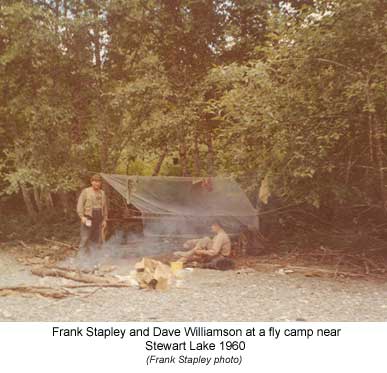 |
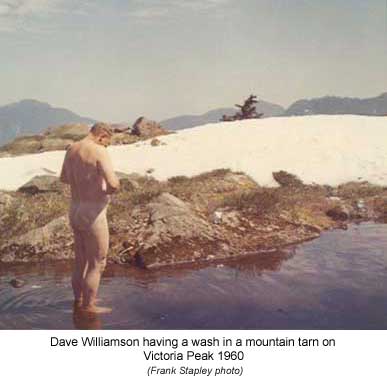 |
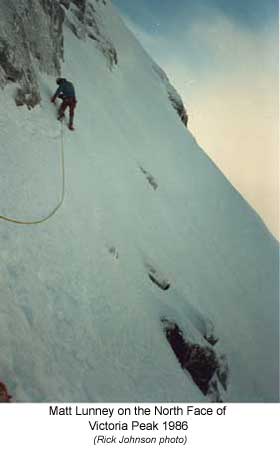 |
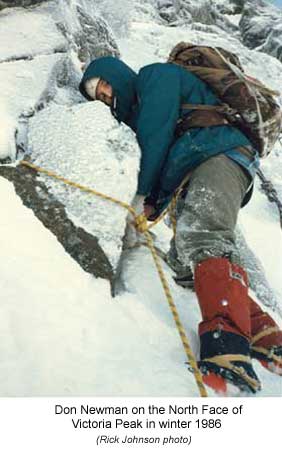 |
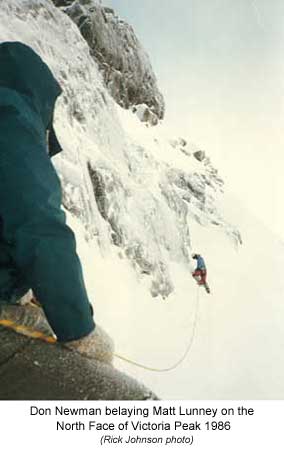 |
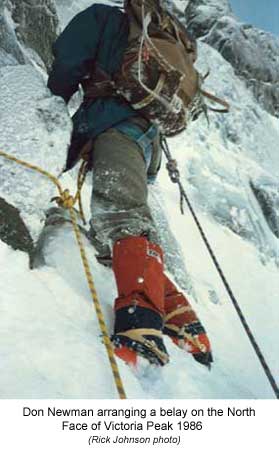 |
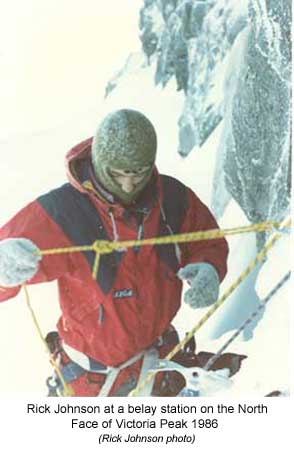 |
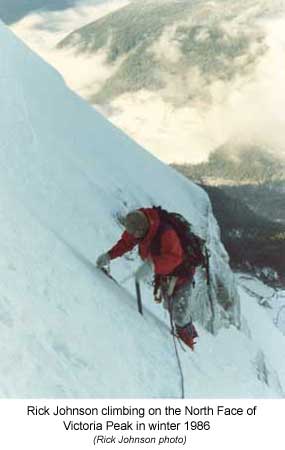 |
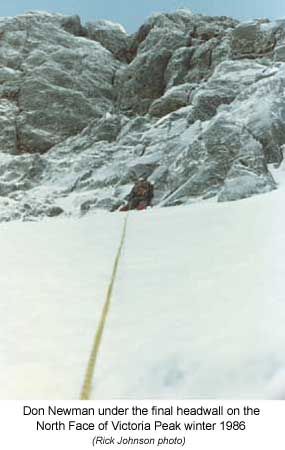 |
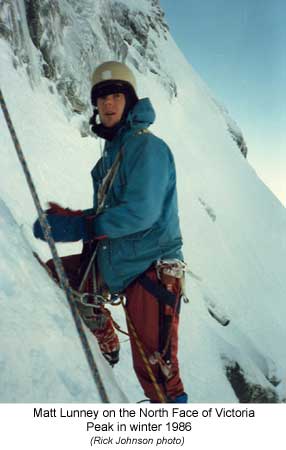 |
How to order | | About the Author || Links || Home
Contact:
Copyright ©
Lindsay Elms 2001. All Rights Reserved.
URL: http://www.beyondnootka.com
http://www.lindsayelms.ca
